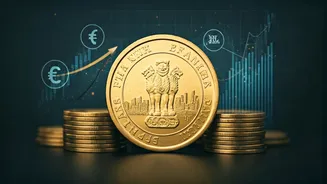UPI's Payment Surge
Unified Payments Interface (UPI) is at the forefront of India's digital payment revolution, showing remarkable growth. A recent report revealed that UPI transactions
have surged nearly sixfold since 2019, showcasing its increasing popularity and adoption across the nation. This surge, according to an RBI report, underscores UPI's significance in transforming the financial landscape. Furthermore, the NPCI has introduced AI-powered 'UPI Help' to address user queries, aiming to enhance user experience and simplify digital payments. This evolution emphasizes the ongoing efforts to refine and improve the digital payment infrastructure, reinforcing India's commitment to a digitally driven economy.
Market Rally & Factors
The stock market recently showed an upward trend, with the Sensex and Nifty experiencing a rally on October 27. Several factors contributed to this positive movement, driving investor confidence and activity in the markets. The rally's momentum was fueled by various underlying conditions. A FinMin report indicated that the Indian economy is showing continued growth, even amidst global uncertainties. Furthermore, the Supreme Court's decision to allow the Centre to review AGR dues of Vodafone Idea also positively impacted market sentiment. These factors collectively strengthened the market's performance, indicating a robust economic environment.
Investment Strategies Examined
Several investment opportunities and strategies have been highlighted. One notable area is the potential for tax-free retirement fund growth through a yearly investment of as little as Rs 500 over 15 years. This approach provides an effective method for long-term financial planning. Moreover, the re-opening of Silver ETF FoFs by mutual funds, responding to price adjustments and strong demand, offers another avenue for investors. Additional insights include how to approach saving and investments along with the differences between a Public Provident Fund (PPF) and a personal loan, including their interest rates and eligibility criteria. These options provide individuals with diverse strategies for wealth management and financial security.
Real Estate Trends
The real estate market shows signs of revival and expansion. The India Housing Sentiment Index has rebounded to 142, indicating a renewed confidence among buyers. Industry players also observe that the festive season has boosted confidence in land investments. The Navi Mumbai International Airport, nearing its launch, has spurred property development in Panvel, Ulwe, and Kharghar. Additionally, the article highlights the growth potential in Gurgaon's real estate sector, identifying top micro-markets with a potential growth of 1.0-1.6x within five years. The sector is seeing activity across different geographies, influenced by infrastructural developments, and shifting buyer sentiments.
IPO Market Activity
The IPO market is experiencing a flurry of activity, signaling an optimistic outlook for capital markets. The market is preparing for a wave of listings, estimating approximately Rs 40,000 crore worth of IPOs by the end of November. Several companies are preparing to launch their IPOs, including Orkla India. Also, the Lenskart IPO is on the horizon, with details about the opening date, price band, and grey market premium (GMP) are available. Jayesh Logistics and Midwest IPOs have also attracted attention. These upcoming IPOs underscore the investor interest and confidence, contributing to the expansion of investment options available in the Indian markets.
Banking and Finance News
Numerous updates and changes are occurring within the banking and finance sector. A new bank rule will allow individuals to add up to four nominees. Banks may also soon finance domestic and overseas acquisitions under new RBI guidelines. There are also reports on the performance of banks, such as Kotak Mahindra Bank, whose profit dipped by 2.7% to Rs 3,253 crore in the latest quarter. Moreover, the EPFO’s EDLI scheme provides up to Rs 7 lakh life cover, detailing eligibility and benefits. These updates reflect the changing dynamics of the financial environment and regulatory adaptations.













